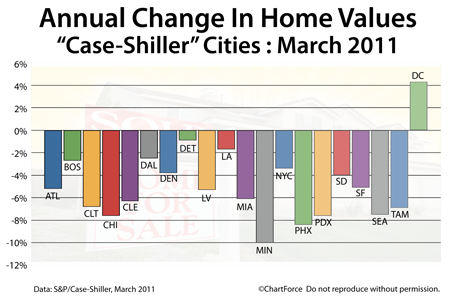St Paul Central Area MLS Single Family Sold Homes in April 2011
The 50 Most Expensive Small Towns In The United States
 According to the National Association of REALTORS®, foreclosures and other “distressed properties” sell at discounts of 20 percent of more. Discounts of that size affect pricing in the broader housing market, too. It’s among the reasons why median home prices are dropping.
According to the National Association of REALTORS®, foreclosures and other “distressed properties” sell at discounts of 20 percent of more. Discounts of that size affect pricing in the broader housing market, too. It’s among the reasons why median home prices are dropping.
Not all markets are affected equally, however. In a recent BusinessWeek analysis, it was shown that one-third of the nation’s 50 most expensive small towns experienced a median price increase between 2010 and 2011.
Topped by Sagaponack, New York — a town of only 582 residents — each of the cities carries a median home price of more than $1,000,000, and a total population of 10,000 or less.
The list is dominated by New York and California, with 22 and 13 entrants, respectively. The rest of the towns are spread throughout the country, including Chilmark, MA (#28), Yarrow Point, WA (#29) and Belle Meade, TN (#48).
The complete Top 10 follows:
- Sagaponack :
$3,406,640, -14.5%Jupiter Island, FL : $2,810,434 -11.3%Kings Point, NY : $2,379,905 +13.5%Los Altos Hills, CA : $2,161,255 -13.6%Water Mill, NY : $2,111,688 -10.0%Belvedere, CA : $2,100,453 + 1.3%Rolling Hills, CA : $2,063,917 +7.3%Hidden Hills, CA : $1,871,182 +0.7%Sands Point, NY : $1,823,677 +9.0%Woodside, CA : $1,792,837 -15.7%
$3,406,640, (-14.5% from 2010)
- Jupiter Island, FL : $2,810,434 (-11.3% from 2010)
- Kings Point, NY : $2,379,905 (+13.5% from 2010)
- Los Altos Hills, CA : $2,161,255 (-13.6% from 2010)
- Water Mill, NY : $2,111,688 (-10.0% from 2010)
- Belvedere, CA : $2,100,453 (+1.3% from 2010)
- Rolling Hills, CA : $2,063,917 (+7.3% from 2010)
- Hidden Hills, CA : $1,871,182 (+0.7% from 2010)
- Sands Point, NY : $1,823,677 (+9.0% from 2010)
- Woodside, CA : $1,792,837 (-15.7% from 2010)
See the complete list at the BusinessWeek website.
Case-Shiller Shows Home Values Rolling Back 9 Years

The March Case-Shiller Index was released this week and it corroborates the findings of the government’s most recent Home Price Index — home values are slipping nationwide.
According to the Case-Shiller Index’s publisher, Standard & Poors, home values fell in March from the year prior.
The March report was among the worst Case-Shiller Index readings in 3 years. On a monthly basis, 18 of 20 tracked markets worsened. Only Seattle and Washington, D.C. showed improvement, rising 0.1% and 1.1%, respectively.
On an annual basis, price degradation was even worse.
Washington, D.C. is the only tracked market to post higher home values for March 2011 as compared to March 2010. The national index has now dropped to mid-2002 levels.
As a buyer in today’s market, though, you can’t take the Case-Shiller Index at face value. It’s methodology is far too flawed to be the “final word” in home prices.
The first big Case-Shiller Index flaw is its relatively small sample size. S&P positions the Case-Shiller Index as a national index but its data comes from just 20 cities total. And they’re not the 20 most populous cities, either. Notably missing from the Case-Shiller Index list are Houston (#4), Philadelphia (#5), San Antonio (#7) and San Jose (#10).
Minneapolis (#48) and Tampa (#55) are included, by contrast.
A second Case-Shiller flaw is how it measures a change in home price. Because the index throws out all sales except for “repeat sales” of the same home, the Case-Shiller Index fails to capture the “complete” U.S. market. It also specifically excludes condominiums and multi-family homes.
In some cities — such as Chicago — homes of these types can represent a large percentage of the market.
And, lastly, a third Case-Shiller Index flaw is that it’s on a 2-month delay. It’s June and we’re only now getting home data from March. Today’s market is similar — but not the same — to what buyers and sellers faced in March. The Case-Shiller Index is far less useful than real-time data of a city or neighborhood.
The Case-Shiller Index is more useful to economists and policy-makers than to everyday buyers and sellers in St Paul. For better real estate data for your particular neighborhood, ask your real estate agent for help.
A real estate agent can tell you which homes have sold in the last 7 days, and at what prices. The Case-Shiller Index cannot.